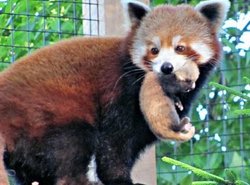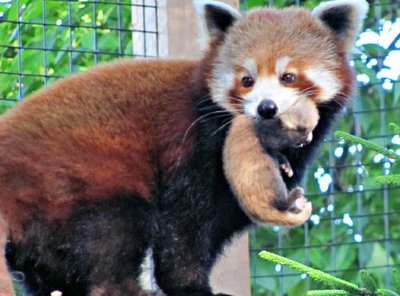Jeff Wiehe | The Journal Gazette
FORT WAYNE – He had only a 50-50 chance at surviving the first month of his life.
But that doesn't provide any solace to the employees of the Fort Wayne Children's Zoo, where a red panda born there this week was discovered dead.
The male panda had not ingested any milk, meaning he did not nurse or his mother did not produce any for him, the zoo announced on Friday.
"Our staff is truly saddened by this news," Animal Curator Mark Weldon in a written statement.
The cub had been born to Xiao, a 3-year-old female red panda, and her 4-year-old mate, Junjie.
Weighing 4 ounces, the cub had not been named but was under constant observation by zoo workers.
The cub was last seen curled up in his nest, which was normal behavior and was scheduled for a physical exam Friday.
"Our daily visual checks did not reveal any problems with the cub," Weldon said.
About half of red panda cubs born in zoos die within the first month of life, zoo officials said.
This was the second litter of cubs to be born at the zoo since 1997. In 2012, Xiao gave birth to two cubs but neither survived.
Mary Noell, who works at the Cincinnati Zoo and maintains data on all red pandas in the United States and Canadian zoos, said in a written statement this is not an "unusual situation."
"There is a genetic line within this subspecies where (the females) do not produce enough milk," she said.
"Unfortunately we don't know this is a possibility until a cub dies."
In the zoo's statement, Noell said that Xiao's future as a breeding red panda will be evaluated.
Noell and Weldon said either Xiao or Junjie could be moved to another zoo to find a new mate in the future.
[email protected]
~ ~ ~ ~ ~ ~ ~ ~ ~ ~ ~ ~ ~ ~
Last updated: June 4, 2013 10:31 a.m.
Red panda born at Fort Wayne zoo
Statement as issued Tuesday by the Fort Wayne Children's Zoo:
A red panda cub was born at the Fort Wayne Children's Zoo on June 3 to female Xiao (pronounced JOW), age 3, and her 4-year-old mate, Junjie.
This is the second litter of cubs to be born at the zoo since 1997. Two cubs were born to Xiao in 2012, but neither cub survived.
An endangered species, red pandas are difficult to breed and rear in captivity. About half of all cubs die within 30 days of birth. Only a few dozen red panda cubs are born in United States zoos each year.
"The next few weeks are critical to the cub's survival," said Central Zoo Area Manager Shelley Scherer. "Xiao is behaving just as we would expect, so we are cautiously optimistic."
Keepers conducted a brief health check on the cub this morning. The cub, whose gender is not known, weighed 117 grams and was vocalizing. Xiao frequently carries her cub among nest boxes in the exhibit, which is normal behavior.
Contact with Xiao and her cub is extremely limited to minimize stress on the mother and improve the cub's odds of survival. For now, the pathway in front of the red panda exhibit is closed to zoo guests.
Red panda cubs are born blind and deaf. The mother spends nearly all her time nursing and grooming her cubs during the first week. The cubs remain in the nest until they are about three months old.
"If the cub survives, zoo guests are unlikely to see it outside of the nest box until sometime in August or September," said Scherer.
The breeding of red pandas is overseen by the Species Survival Plan (SSP), a program of the Association of Zoos & Aquariums (AZA). The goal of the SSP is to maximize genetic diversity in captive populations of endangered animals.
Red pandas are native to the forested foothills of the Himalaya Mountains in China and Nepal, where they feed primarily on bamboo. Though they share a name with the famed black-and-white giant pandas, the two are not closely related. The name "panda" comes from the Nepalese word ponya, which means "bamboo-eater."
Jeff Wiehe | The Journal Gazette
FORT WAYNE – He had only a 50-50 chance at surviving the first month of his life.
But that doesn't provide any solace to the employees of the Fort Wayne Children's Zoo, where a red panda born there this week was discovered dead.
The male panda had not ingested any milk, meaning he did not nurse or his mother did not produce any for him, the zoo announced on Friday.
"Our staff is truly saddened by this news," Animal Curator Mark Weldon in a written statement.
The cub had been born to Xiao, a 3-year-old female red panda, and her 4-year-old mate, Junjie.
Weighing 4 ounces, the cub had not been named but was under constant observation by zoo workers.
The cub was last seen curled up in his nest, which was normal behavior and was scheduled for a physical exam Friday.
"Our daily visual checks did not reveal any problems with the cub," Weldon said.
About half of red panda cubs born in zoos die within the first month of life, zoo officials said.
This was the second litter of cubs to be born at the zoo since 1997. In 2012, Xiao gave birth to two cubs but neither survived.
Mary Noell, who works at the Cincinnati Zoo and maintains data on all red pandas in the United States and Canadian zoos, said in a written statement this is not an "unusual situation."
"There is a genetic line within this subspecies where (the females) do not produce enough milk," she said.
"Unfortunately we don't know this is a possibility until a cub dies."
In the zoo's statement, Noell said that Xiao's future as a breeding red panda will be evaluated.
Noell and Weldon said either Xiao or Junjie could be moved to another zoo to find a new mate in the future.
[email protected]
~ ~ ~ ~ ~ ~ ~ ~ ~ ~ ~ ~ ~ ~
Last updated: June 4, 2013 10:31 a.m.
Red panda born at Fort Wayne zoo
Statement as issued Tuesday by the Fort Wayne Children's Zoo:
A red panda cub was born at the Fort Wayne Children's Zoo on June 3 to female Xiao (pronounced JOW), age 3, and her 4-year-old mate, Junjie.
This is the second litter of cubs to be born at the zoo since 1997. Two cubs were born to Xiao in 2012, but neither cub survived.
An endangered species, red pandas are difficult to breed and rear in captivity. About half of all cubs die within 30 days of birth. Only a few dozen red panda cubs are born in United States zoos each year.
"The next few weeks are critical to the cub's survival," said Central Zoo Area Manager Shelley Scherer. "Xiao is behaving just as we would expect, so we are cautiously optimistic."
Keepers conducted a brief health check on the cub this morning. The cub, whose gender is not known, weighed 117 grams and was vocalizing. Xiao frequently carries her cub among nest boxes in the exhibit, which is normal behavior.
Contact with Xiao and her cub is extremely limited to minimize stress on the mother and improve the cub's odds of survival. For now, the pathway in front of the red panda exhibit is closed to zoo guests.
Red panda cubs are born blind and deaf. The mother spends nearly all her time nursing and grooming her cubs during the first week. The cubs remain in the nest until they are about three months old.
"If the cub survives, zoo guests are unlikely to see it outside of the nest box until sometime in August or September," said Scherer.
The breeding of red pandas is overseen by the Species Survival Plan (SSP), a program of the Association of Zoos & Aquariums (AZA). The goal of the SSP is to maximize genetic diversity in captive populations of endangered animals.
Red pandas are native to the forested foothills of the Himalaya Mountains in China and Nepal, where they feed primarily on bamboo. Though they share a name with the famed black-and-white giant pandas, the two are not closely related. The name "panda" comes from the Nepalese word ponya, which means "bamboo-eater."


